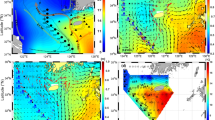Abstract
The current structures and their seasonal variations in the East Korean Warm Current (EKWC) region, which plays a significant role in the northward transport of warm and saline waters, were described by combining the sea surface temperature (SST) data of consecutive satellite inferred (IR) images and hydrographic data. The SST patterns in winter-spring clearly showed that the small meander of thermal front originating from the Tsushima/Korea Strait formed close to the Korean coast and grew an isolated warm eddy with horizontal dimension of order 100 km. Such warm eddy began to intrude slowly northward from spring to summer. At that time, interactions with neighboring synoptic warm eddy [Ks] around the Ulleung Basin were found to have strongly influence the movement of the intruding eddy and its structural change. In autumn, after the northward movement stopped at the north of eddy [Ks], the relative stable northward current along the Korean coast were formed. The evidence from observational results does not support a persistent branching of the EKWC from the Tsushima/Korea Strait, but a seasonal episodic supply of warm and saline waters due to the northward intruding eddy process described above.
Similar content being viewed by others
References
Fisheries Agency, Japan (1990): The Results of Fisheries Oceanographical Observation in 1987.
Fisheries Research and Development Agency, Korea (1988): Annual report of oceanographic observations in 1987, 36.
Gong, Y., T. Hirano and C. I. Zhang (1985): A study on oceanic environmental conditions for Pacific Saury in Korean waters.Bull. Jap. Soc. Fish. Oceanogr.,47,48 36–58.
Ichiye, T. (1991): Outflows from straits p. 223–230. In:Oceanography of Asian Marginal Seas, Vol. 54, ed. by K. Takano, Elsevier, Amsterdam.
Isoda, Y. and M. Nishihara (1992): Behavior of warm eddies in the Japan Sea.Umi to Sora,67, 53–65 (in Japanese).
Isoda, Y. and H. Yamaoka (1991): Flow structure of the Tsushima Warm Current passing through the Tsushima Straits.Bull. Coastal Oceanogr.,28, 183–194 (in Japanese).
Isoda, Y., S. Saitoh and M. Mihara (1991): SST structure of the polar front in the Japan Sea. p. 103–112. InOceanography of Asian Marginal Seas, Vol. 54, ed. by K. Takano, Elsevier, Amsterdam.
Isoda, Y., M. Naganobu, H. Watanabe and K. Nukata (1992): Horizontal and vertical structures of a warm eddy above the Yamato Rise:Umi no Kenkyu,1, 151–151 (in Japanese).
Japan Maritime Safety Agency (1992): Monthly mean maps of 100 m isotherms from the climatological mean from 1906 to 1987, in the Quick Bulletin of Oceanic Condition.
Kawabe, M. (1982a). Branching of the Tsushima Current in the Japan Sea, Part I. Data analysis.J. Oceanogr. Soc. Japan,38, 95–107.
Kawabe, M. (1982b): Branching of the Tsushima Current in the Japan Sea, Part II. Numerical experiment.J. Oceanogr. Soc. Japan,38, 183–192.
Kim, C. H., H. J. Lie, and K. S. Chu (1991): On the intermediate water in the southwestern East Sea (Sea of Japan). p. 129–141. InOceanography of Asian Marginal Seas, Vol. 54, ed. by K. Takano, Elsevier, Amsterdam.
Kim, K. and R. Legeckis (1986): Branching of the Tsushima Current in 1981–83.Prog. Oceanogr.,17, 265–276.
Kim, K., K. R. Kim, J. Y. Chung and H. S. Yoo (1991): Characteristics of physical properties in the Ulleung Basin.J. Oceanogr. Soc. Korea,26, 83–100.
Ogawa, Y. (1983): Seasonal changes in temperature and salinity of water flowing into the Japan Sea through the Tsushima Straits.Bull. Japan. Soc. Fish. Oceanogr.,43, 1–8 (in Japanese).
Sekine, Y. (1986): Wind-driven circulation in the Japan Sea and its influence on the branching of the Tsushima Current.Prog. Oceanogr.,17, 297–312.
Suda, K. and K. Hidaka (1932): The results of the oceanographical observations on board R. M. S. in the summer of 1929, Part 1.J. Oceanogr. Imp. Mar. Observ.,3, 291–375 (in Japanese).
Tameishi, H. (1987): Application of the NOAA images for the fishery (Sea area around the Tsushima islands).Bull. Jap. Soc. Fish. Oceanogr.,51, 238–244 (in Japanese).
Tanioka, K. (1962): Oceanographical conditions of the Japan Sea (II)—On the cold and the warm region and haline water.Umi to Sora,38, 9–22 (in Japanese).
Tanioka, K. (1966): Oceanographical conditions of the Japan Sea (IV)—On the vertical section across Tosen warm current.Umi to Sora,41, 50–57 (in Japanese).
Tanioka K. (1968) On the East Korean Warm Current (Tosen Warm Current).Oceanogr. Mag.,20, 31–38.
Toba, Y., H. Kawamura, F. Yamashita and K. Hanawa (1984): Structure of horizontal turbulence in the Japan Sea. p. 317–332. InOcean Hydrodynamics of the Japan and East China Seas, Vol. 39, ed. by T. Ichiye, Elsevier, Amsterdam.
Uda, M. (1934): The results of simultaneous oceanographical investigations in the Japan Sea and its adjacent waters in May and June 1932.J. Imp. Fisher. Exp. St.,5, 57–190 (in Japanese).
Yoon, J. H. (1982a): Numerical experiment on the circulation in the Japan Sea, Part I. Formation of the East Korean Warm Current.J Oceanogr. Soc. Japan,38, 43–51.
Yoon, J. H. (1982b): Numerical experiment on the circulation in the Japan Sea, Part II Influence of seasonal variations in atmospheric conditions on the Tsushima Current.J Oceanogr. Soc. Japan,38, 81–94.
Author information
Authors and Affiliations
Rights and permissions
About this article
Cite this article
Isoda, Y., Saitoh, Si. The northward intruding eddy along the East coast of Korea. J Oceanogr 49, 443–458 (1993). https://doi.org/10.1007/BF02234959
Received:
Revised:
Accepted:
Issue Date:
DOI: https://doi.org/10.1007/BF02234959



